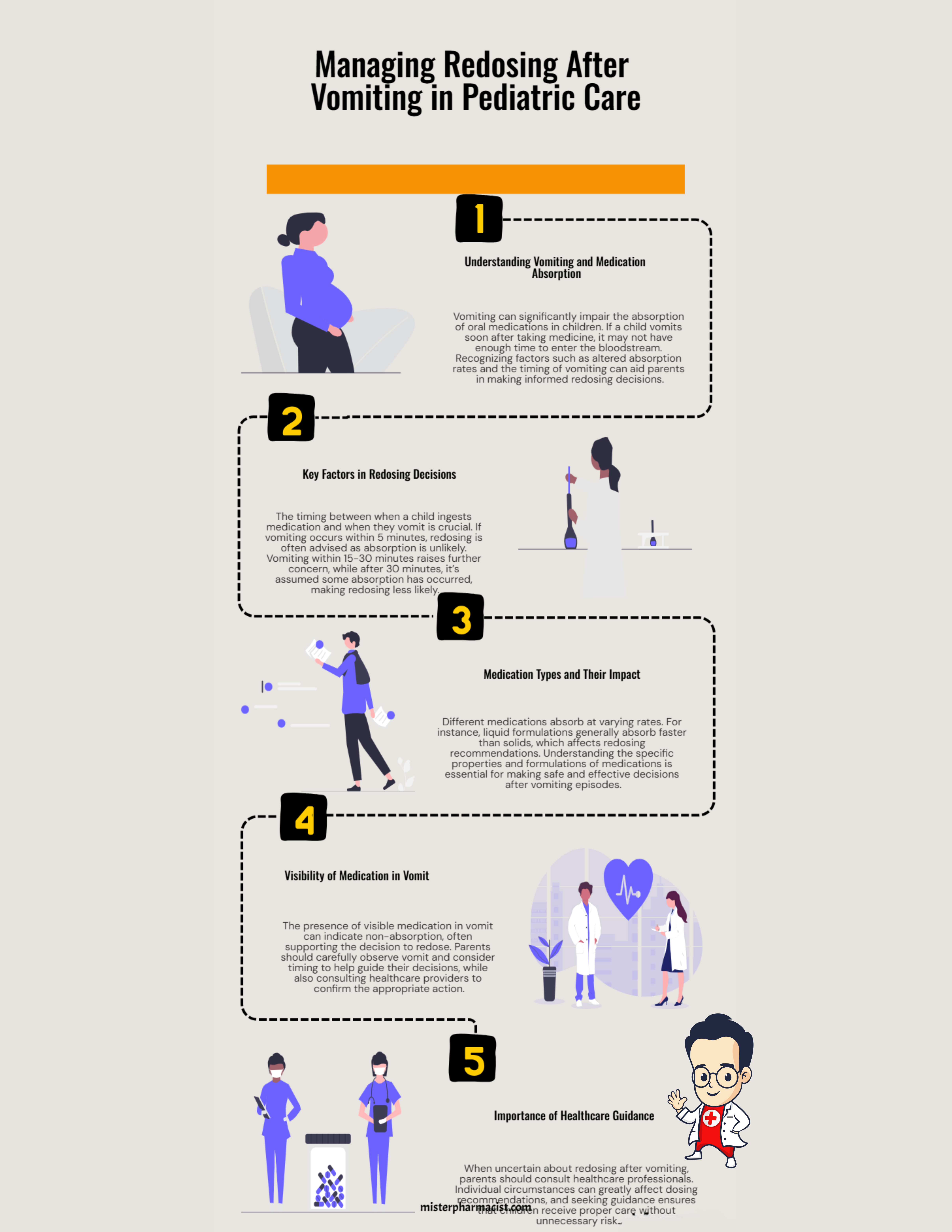Redosing After Vomiting: A Guide for Parents
Introduction
Redosing after vomiting is a critical topic for parents managing the health of their children. This issue holds particular significance in pediatric care, where medication safety is paramount. When a child vomits shortly after taking oral medication, determining whether to redose can be challenging.
This article serves as a guide for parents, providing insights into:
- Key factors influencing redosing decisions
- Practical advice based on healthcare professionals’ perspectives
Understanding these elements helps ensure that caregivers make informed choices in response to their child’s needs. By recognizing the appropriate protocols, parents can navigate the complexities of administering medications effectively and safely.
For additional support with medication management, MisterPharmacist, Toronto’s online pharmacy, offers fast prescription delivery services. Their resources can be invaluable in ensuring timely access to necessary medications. Furthermore, exploring their pharmacy insider tips could provide further insights into safe medication practices.
Understanding Vomiting and Its Impact on Medication Absorption
Vomiting, also known as emesis, is a complex physiological response that involves the expulsion of stomach contents through the mouth. This reflex can be triggered by various factors, including illness, medication side effects, or gastrointestinal disturbances. The act of vomiting not only causes discomfort but also has significant implications for medication administration in pediatric patients.
When a child vomits shortly after taking oral medication, the absorption of that medication may be compromised. Key points to consider include:
- Altered Absorption: Medications rely on proper gastrointestinal function for optimal absorption. If a child vomits soon after ingestion, the medication may not have had sufficient time to enter the bloodstream effectively.
- Importance of Timing: The timing between medication ingestion and vomiting is crucial. A shorter interval generally indicates a higher likelihood that the medication was not absorbed.
- Impact on Treatment: Reduced absorption can lead to inadequate therapeutic effects, complicating treatment plans for conditions requiring precise dosing.
Understanding these factors helps parents make informed decisions regarding redosing after a vomiting episode. Recognizing how vomiting affects medication efficacy is essential in pediatric care.
Key Factors Influencing Redosing Decisions After Vomiting
1. Time Between Ingestion and Vomiting
The timing between ingestion of medication and subsequent vomiting is crucial in determining whether to redose a child. Healthcare professionals emphasize the importance of timing when making this decision. Here are key guidelines based on consensus from various medical sources:
- Vomiting within 5 minutes: If a child vomits within this short window, it is generally considered that the medication has not had sufficient time to be absorbed into the bloodstream. In such cases, it is usually safe to redose. The rationale behind this recommendation stems from the belief that most oral medications require at least a few minutes to begin dissolving and entering the gastrointestinal tract.
- Vomiting within 15 to 30 minutes: This timeframe often raises questions about the effectiveness of the initial dose. Healthcare providers typically advise parents to consider redosing if vomiting occurs within 30 minutes of administration. The likelihood that the medication was expelled before absorption increases during this period. Observing for any visible medication in the vomit can also guide this decision.
- Vomiting after 30 minutes: If more than 30 minutes have passed since taking the medication, redosing might not be necessary. At this point, it is assumed that some level of absorption may have occurred, depending on the specific medication’s properties and formulation.
Several factors can further influence these guidelines:
- Type of Medication: Different medications have varying absorption rates and bioavailability profiles. For example, liquid formulations often absorb faster than solid tablets or capsules. Understanding these differences helps in making informed decisions regarding redosing.
- Patient Condition: The child’s overall health status plays a significant role in redosing decisions. If a child shows signs of dehydration or distress after vomiting, contacting a healthcare professional becomes vital before administering another dose.
- Clinical Judgment: Many healthcare providers rely on their experience and knowledge when determining whether to redose after vomiting. Individual circumstances surrounding each case may lead to different recommendations.
The importance of timing cannot be overstated when considering redosing after vomiting. Parents should remain vigilant about the timing of both medication administration and any subsequent vomiting episodes, as this directly impacts treatment efficacy and safety for pediatric patients.
2. Medication Type Effects on Redosing Decisions
The type of medication plays a crucial role in determining redosing decisions after a child vomits. Different medications have varying absorption rates, which can significantly influence the efficacy of treatment following an episode of vomiting.
Importance of Timing
The timing between ingestion and vomiting is essential. For instance:
- If a child vomits within 5 minutes, it is likely that the medication has not been absorbed at all. Redosing may be warranted.
- Vomiting occurring within 30 minutes may also suggest insufficient absorption, depending on the specific medication.
Medication Formulation
Variations in formulations (e.g., liquid vs. tablet) further impact absorption rates. Liquid medications generally absorb faster than tablets or capsules, leading to different redosing considerations.
Specific Medications
Certain medications, such as those with delayed-release properties, require careful consideration. If these are vomited shortly after administration, redosing might not be necessary as their absorption is designed to occur over a longer duration.
Understanding these factors helps parents make informed decisions regarding redosing after vomiting episodes in children. Each situation requires careful assessment of both timing and the particular medication involved to ensure effective treatment while prioritizing safety.
3. Patient Condition Considerations in Pediatric Patients
When making decisions about redosing after vomiting, it’s important to understand the specific needs of pediatric patients. Children are more likely to have issues with medication absorption because their gastrointestinal systems are still developing and their metabolic rates are different. Here are several factors that must be taken into account:
1. Timing of Vomiting
The timing between when a child takes medication and when they vomit is crucial in deciding whether to redose.
- If a child vomits within 5 minutes, there is a high chance that the medication has not been absorbed, which usually leads to a recommendation for redosing.
- Vomiting occurring within 30 minutes still raises concerns about absorption. In such cases, healthcare professionals may suggest redosing based on the child’s condition and the specific medication taken.
2. Child’s Overall Health
Assessing the child’s general health status is essential. Children with pre-existing conditions or those who are dehydrated may require different considerations when deciding on redosing. For instance, dehydration can significantly affect medication absorption, which makes it vital for healthcare professionals to monitor hydration levels closely.
3. Medication Type
Various medications have differing absorption characteristics. Understanding how a specific drug interacts with the digestive system can inform redosing decisions. This is particularly relevant in cases where the medication type includes treatments that require specific timing or conditions for optimal absorption.
Moreover, some cases might benefit from the use of supplements like zinc, which can play a role in managing certain symptoms or conditions related to vomiting in children.
These considerations highlight the importance of personalized approaches in pediatric care, ensuring safety while effectively managing treatment for children after episodes of vomiting. It’s crucial to remember that each child’s situation is unique, and thus requires an individualized assessment and treatment plan.
4. Visibility in Vomit: A Factor to Consider When Redosing Medications After Vomiting Occurs
When a child vomits after taking medication, the visibility of the medication in the vomit plays a crucial role in determining whether to redose. Key considerations include:
1. Visible Medication
If you can see the medication in the vomit, it often indicates that the drug was not absorbed into the system. In such cases, redosing is generally recommended.
2. Timing Matters
The timing of vomiting is critical:
- Vomit within 5 minutes: If vomiting occurs shortly after ingestion, it is likely that the medication has not yet been absorbed. Redosing may be appropriate.
- Vomit within 30 minutes: Similar guidelines apply. This timeframe suggests that absorption has not taken place, supporting a decision to redose.
3. Absence of Visible Medication
If there are no traces of the medication in the vomit and it occurred after a longer period, caution is advised. In this scenario, consider factors such as the child’s overall condition and any specific characteristics of the medication type.
Understanding these elements helps parents make informed decisions about redosing after vomiting. Recognizing when visible medication is present can significantly influence treatment outcomes for pediatric patients.
Guidelines for Redosing After Vomiting in Pediatric Patients
Redosing after a vomiting episode in children presents unique challenges. Current guidelines for redosing medications lack standardization, leading to variability in practices among healthcare professionals. Key points to consider include:
- Timing: If vomiting occurs within 15 to 30 minutes post-ingestion, many practitioners recommend redosing.
- Visible Medication: If the medication is identifiable in the vomit, it typically indicates that absorption did not occur, supporting the decision to redose.
- Clinical Judgment: Individual circumstances, including the child’s condition and the type of medication, play a crucial role in decision-making.
The absence of uniform guidelines means that most healthcare providers depend on their clinical experience and discretion. Parents should be aware of these considerations when faced with redosing decisions after their child vomits.
Clinical Decision-Making Insights from Healthcare Professionals’ Perspectives on Redosing Medications After Vomiting Occurs
Healthcare professionals play a crucial role in deciding whether to redose medications after a child’s vomiting episode. Recent surveys reveal varying opinions and strategies among these experts:
- Clinical Judgment: Many healthcare providers rely heavily on individual clinical judgment rather than standardized protocols.
- Factors Considered: Common considerations include:
- Time elapsed since medication ingestion
- Child’s overall condition and vital signs
- Type of medication administered
- Consensus on Timing: A notable number of professionals agree that if vomiting occurs within 15 to 30 minutes post-ingestion, redosing is generally recommended. Beyond this window, the decision becomes more nuanced.
The insights gathered underscore the importance of personalized care in pediatric practice, reflecting the diverse experiences and strategies employed by healthcare providers when managing redosing decisions after vomiting incidents.
Prevalence of Vomiting After Oral Medication Administration in Pediatric Patients: Implications for Healthcare Practices
The prevalence of vomiting after oral medication administration in pediatric patients is significant, impacting treatment efficacy and safety. Research indicates that approximately 20% to 30% of children experience vomiting following medication intake. This statistic highlights the importance of understanding how post-medication vomiting can complicate dosing strategies.
Key implications for healthcare practices include:
- Increased Need for Monitoring: Children who vomit may require closer observation to ensure that medications are administered correctly and effectively.
- Adjustment of Dosing Protocols: Understanding the frequency of vomiting can help healthcare providers develop tailored dosing protocols, reducing the risk of underdosing or overdosing.
- Communication with Parents: Educating parents about the possibility of vomiting and redosing guidelines fosters informed decision-making during medication administration.
Awareness of these factors is crucial for optimizing medical care in pediatric patients, ensuring that drug therapies remain effective despite challenges presented by vomiting episodes.
Conclusion: Understanding Redosing Protocols After Vomiting in Pediatric Patients
Parents and caregivers play a crucial role in managing their child’s health. When it comes to redosing after vomiting, consider the following:
- Consult Healthcare Professionals: Always seek advice if unsure about administering medications after a child vomits. Healthcare providers can offer tailored guidance based on individual circumstances.
- Timely Decision-Making: The window of time after vomiting is critical. Quick and informed decisions contribute to effective treatment while prioritizing safety.
Understanding redosing protocols after vomiting is essential for ensuring children receive necessary medications without undue risk. By being proactive and seeking professional advice, you can navigate these challenging situations with confidence.
FAQs (Frequently Asked Questions)
What is the significance of redosing medications after vomiting in pediatric care?
Redosing medications after vomiting is crucial in pediatric care as it directly impacts medication efficacy and safety. Understanding when and how to redose can help ensure that children receive the necessary treatment while minimizing risks associated with improper dosing.
How does vomiting affect the absorption of oral medications in children?
Vomiting, or emesis, can significantly alter the absorption of oral medications. When a child vomits shortly after taking medication, the drug may not be fully absorbed into the bloodstream, potentially leading to inadequate treatment. The physiological effects of vomiting can impair gastrointestinal function, making timely redosing decisions essential.
What are the key timeframes for redosing after a child vomits?
Healthcare professionals generally recommend specific timeframes for redosing after a child vomits. If vomiting occurs within 5 minutes of ingestion, it is usually advised to consider redosing. If it happens within 30 minutes, healthcare providers may also suggest redosing, depending on the medication type and patient condition.
How do different types of medications influence redosing decisions after vomiting?
Different medications have varying absorption rates which can affect redosing decisions. For instance, some medications may require immediate redosing if they are known to be poorly absorbed when vomited, while others may have a longer window for effective absorption. It’s important to consult healthcare guidelines or professionals regarding specific medications.
What role does visibility in vomitus play in deciding whether to redose a child?
The presence of visible medication in vomit can serve as an important indicator when determining whether to administer another dose. If the medication is clearly seen in the vomitus, it suggests that it was not absorbed and may warrant a redose; however, this decision should always be made with guidance from healthcare professionals.
What should parents do if they are unsure about administering medication after their child has vomited?
Parents and caregivers should seek advice from healthcare professionals if they are uncertain about administering medication following a child’s vomiting episode. Timely and informed decision-making is vital to ensure effective treatment while prioritizing the child’s safety.



